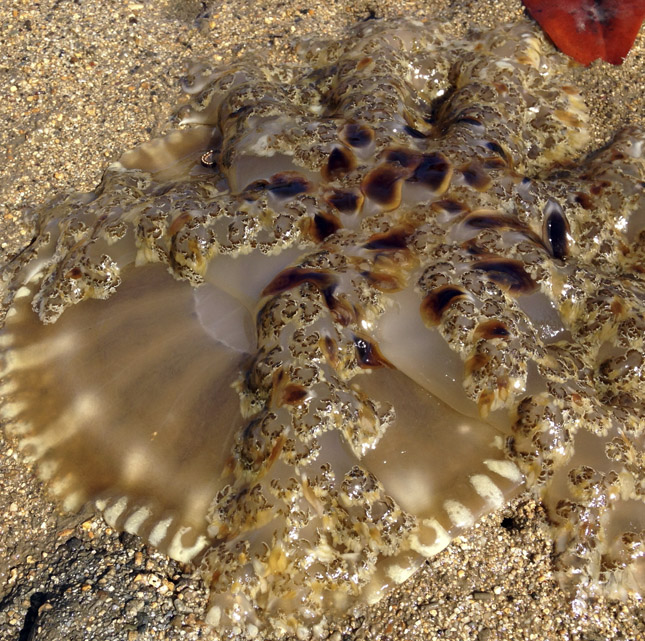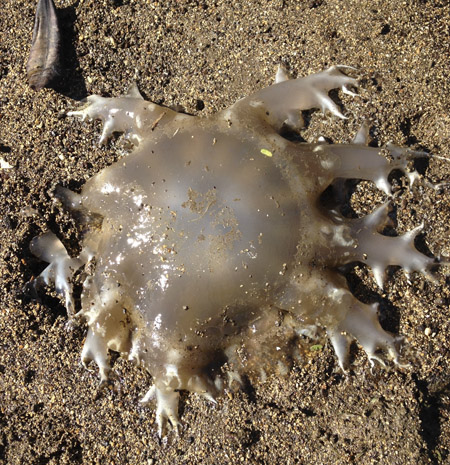Published in the Ocean Watch column, Honolulu Star-Advertiser © Susan Scott
September 22, 2014
- A reader recently came across what she described as pulsating gelatinous creatures on the Kaiwi shoreline.
“Anxious to know what they are,” Jan wrote, and sent two pictures, one taken from each side of the animal.
Jan’s find was an alien creature with a cosmic name: Cassiopea. Most of us, though, call it an upside-down jellyfish.

-
A beached Cassiopea, or upside-down jellyfish,
has frilly “arms” that face up to provide food for the animal.
Courtesy Jan Dettweiler
Upside-down jellyfish live in the reverse position of most jellyfish, with bell on the seafloor and frilly arms facing up. That’s because those lovely lacy limbs contain algae that, like reef corals, contribute to the jellies’ food supply.
Like all plants, algae need sunlight to grow, and that’s what turns the world upside down for these creatures. The bell in this case works as a gentle suction cup to hold the animal in position on the bottom.
The algae give the bushy arms their color of brown, green or blue.
Upside-down jellyfish are not native to Hawaii. Oahu hosts two species (there are eight worldwide), delivered here by accident in ships’ ballast water, probably in the 1940s.
-
 The underside of a beached Cassiopea, or upside-down jellyfish.
The underside of a beached Cassiopea, or upside-down jellyfish.
Courtesy Jan Dettweiler
One of our species is native to the Red Sea and Atlantic Ocean. The jelly grows about 12 inches across and lives in shallow lagoons, sand flats and around mangroves (not native to Hawaii, either) on the leeward side of the island.
Years ago the Duke Kahanamoku Lagoon, adjacent to the Hilton Hawaiian Village, was a good place to watch these elegant jellyfish pulsing in the shallows like flowers with heartbeats. The pulses direct animal plankton toward stinging cells around the jellies’ hundreds of mouths tucked in folds of the frills.
When their water is disturbed, upside-down jellies release loads of free-floating stinging cells. For most people the stings are just prickles on areas of tender skin. Large numbers of stings, though, can get your attention. I paid for my snorkeling excursions in the lagoon with mild, itchy stings to my face and neck.
To me, watching those out-of-this-world jellies was worth some discomfort, but others didn’t see it that way. In 2006 the lagoon owners drained the water and installed a new circulation system. Alas, the upturned jellyfish are now gone.
Oahu’s other kind of upside-down jelly is in Kaneohe Bay and other windward areas, including, apparently, some places on the Kaiwi Coast. DNA studies suggest that this species came from the Western Pacific, possible New Guinea.
Cassiopea may not look like much lying on a beach, but in their element, the jellies dance like the stars. See one at bit.ly/1uy4mwZ.
[embedyt] https://www.youtube.com/watch?v=3Mlg5UGR548[/embedyt]